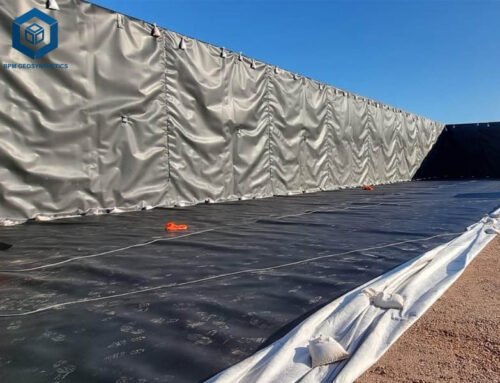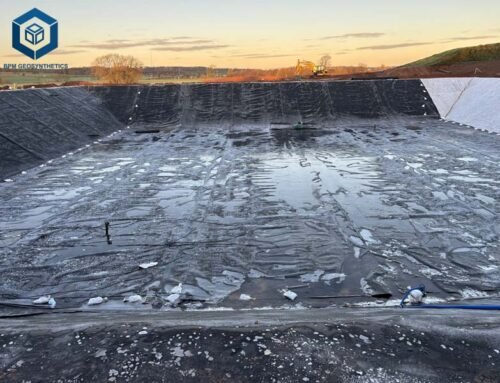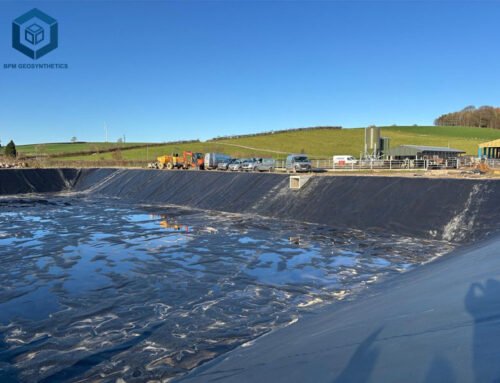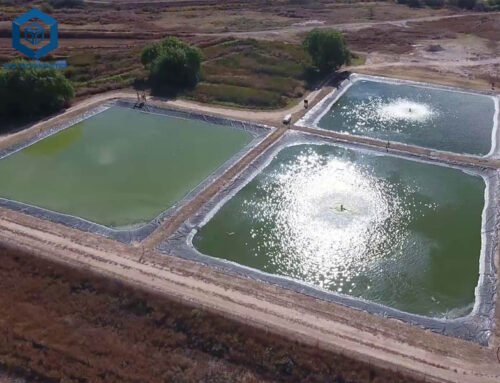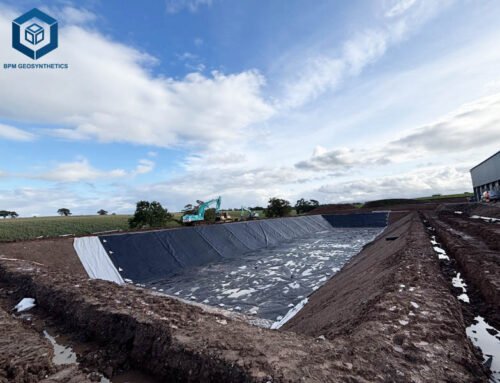Dam liner welding machines are indispensable tools for ensuring the integrity of geomembrane installations, such as pond liners, landfill liners, and agricultural reservoirs. With the global geomembrane market valued at USD 2.1 billion in 2023 and projected to grow at a 6.5% CAGR through 2030, High-Density Polyethylene (HDPE) liners dominate 70% of the market due to their durability and impermeability (1×10^-17 cm/s permeability coefficient). Properly welded dam liners achieve 99.9% water retention, critical for applications like aquaculture, where global demand has surged 8% annually. Selecting the right welding machine is crucial, as poor welds can lead to leaks, costing up to $10,000 in repairs for large reservoirs. This comprehensive guide explores the types, specifications, features, and considerations for choosing the best dam liner welding machine, offering actionable insights for farmers, contractors, and engineers to achieve durable, leak-proof seams.
1. What is a Dam Liner Welding Machine?
A dam liner welding machine is a specialized device designed to join geomembrane sheets, such as HDPE, Low-Density Polyethylene (LDPE), or Polyvinyl Chloride (PVC), to create watertight seams for water containment systems. These machines use thermal fusion techniques—hot wedge or hot air—to melt the surfaces of overlapping liners, which are then pressed together to form a permanent bond. According to industry data, 95% of geomembrane installations rely on welding machines to achieve seam strengths of 80–90% of the parent material’s tensile strength (15–20 MPa for HDPE per ASTM D412). The right machine ensures compliance with standards like ASTM GRI-GM13, reducing leak risks by 98% and extending liner lifespan to 50–100 years.
Importance of Dam Liner Welding
Effective welding is critical for:
- Water Retention: Ensures 99.9% impermeability, preventing water loss in ponds and reservoirs.
- Structural Integrity: Welded seams withstand 4409 N puncture resistance, protecting against root or debris damage.
- Cost Savings: Prevents costly repairs, with leak-related losses averaging $5,000–$10,000 for a 1000 m² pond.
- Environmental Protection: In landfill applications, welded liners prevent 99% of contaminant seepage, meeting EPA standards.
Applications of Dam Liner Welding Machines
These machines are used in diverse sectors:
- Agriculture: Welding liners for irrigation ponds and fish farms, with 80% of global aquaculture ponds using HDPE liners.
- Environmental Management: Sealing landfill liners to prevent leachate leakage, critical for 90% of municipal waste facilities.
- Civil Engineering: Lining reservoirs, canals, and tunnels, with projects over 5000 m² requiring high-capacity welders.
- Mining: Containing tailings and wastewater, where welded HDPE liners handle pH 2–12 conditions.
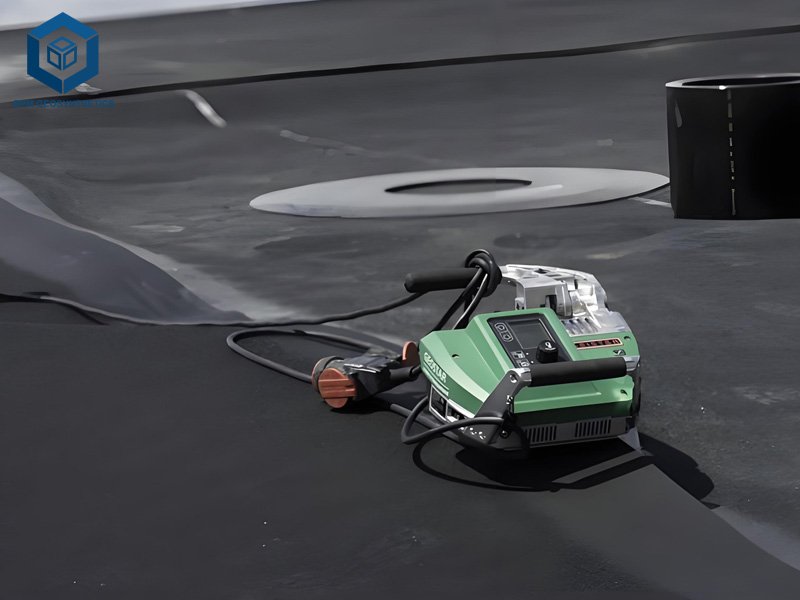
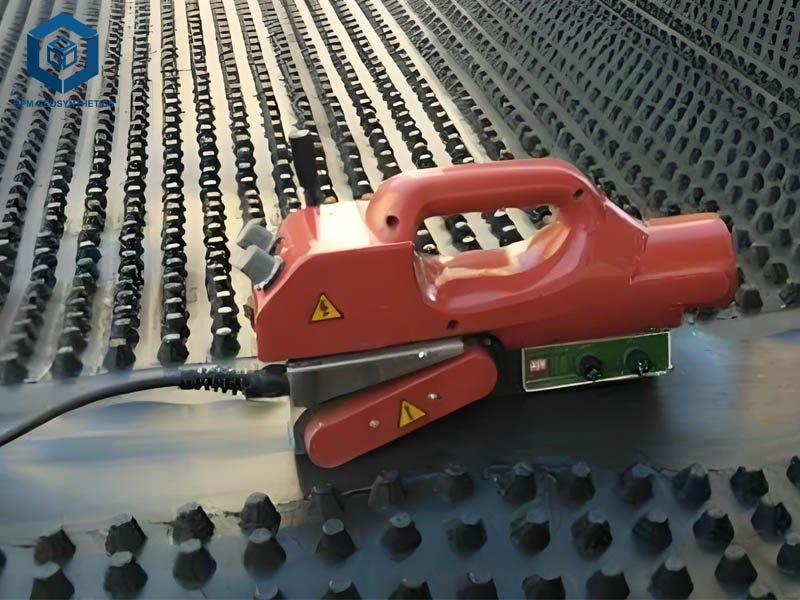
2. Types of Dam Liner Welding Machine
Dam liner welding machines come in two primary types: hot wedge and hot air welders. Each has distinct features, specifications, and applications, influencing their suitability for specific projects.
2.1 Dam Liner Welding Machine – Hot Wedge Welding Machines
Hot wedge welders use a heated metal wedge to melt overlapping geomembrane surfaces, which are then pressed together by rollers. They are the industry standard for large-scale projects, used in 70% of HDPE installations.
- Specifications:
- Power: 800–3000 W, with 220–240 V input.
- Welding Speed: 0.5–8 m/min, adjustable for liner thickness.
- Seam Width: 15–45 mm, with dual seams for air channel testing.
- Temperature Range: 60–450°C, suitable for HDPE (0.3–3 mm) and LDPE.
- Weight: 15–40 kg, with automated models weighing up to 50 kg.
- Applications: Large ponds, landfills, and mining projects requiring 1–3 mm thick liners.
- Cost: $2,000–$10,000, with high-end models like Leister TWINNY T7 costing $8,000–$9,000.
- Advantages:
- Uniform welds, reducing errors by 95% compared to manual methods.
- High speed, completing 500 m²/day for 1.5 mm HDPE.
- Dual seams with air channels for ASTM D7177 testing.
- Disadvantages:
- Higher cost, 30–10% more than hot air welders.
- Less portable, requiring stable power sources (220 V or generators).
2.2 Dam Liner Welding Machine – Hot Air Welding Machines
Hot air welders use a blower to direct heated air (up to 600°C) onto geomembrane surfaces, which are manually pressed together using a roller. They are ideal for smaller projects and repairs.
- Specifications:
- Power: 1500–3400 W, with 110–240 V input.
- Welding Speed: 0.5–3 m/min, slower due to manual operation.
- Seam Width: 20–40 mm, single seam.
- Temperature Range: 100–600°C, suitable for HDPE, LDPE, and PVC (0.3–1 mm).
- Weight: 0.5–5 kg, highly portable.
- Applications: Small ponds, repairs, and detailed work like T-seams or patches.
- Cost: $500–$2,500, with models like Grekkon’s hot air welder at $450.
- Advantages:
- Lightweight and portable, ideal for remote sites.
- Lower cost, saving 50–70% compared to hot wedge welders.
- Versatile for thin liners (0.3–0.8 mm) and repairs.
- Disadvantages:
- Slower, completing 100–200 m²/day.
- Higher risk of human error, with 10–15% weaker seams if not properly executed.
2.3 Dam Liner Welding Machine – Comparison of Hot Wedge vs. Hot Air Welders
| Feature | Hot Wedge Welder | Hot Air Welder |
| Welding Speed | 0.5–8 m/min | 0.5–3 m/min |
| Seam Strength | 90% of parent material | 80–85% of parent material |
| Power Consumption | 800–3000 W | 1500–3400 W |
| Portability | 15–50 kg, less portable | 0.5–5 kg, highly portable |
| Cost | $2,000–$10,000 | $500–$2,500 |
| Best For | Large-scale, thick liners | Small projects, repairs |
Hot wedge welders are preferred for 70% of large-scale projects due to their speed and reliability, while hot air welders dominate 60% of small-scale and repair applications.
3. Key Features To Look For In A Dam Liner Welding Machine
Selecting the best dam liner welding machine requires evaluating key features that impact performance, durability, and ease of use. Below are the critical features to consider:
3.1 Dam Liner Welding Machine – Welding Speed and Efficiency
- Importance: Faster welding speeds reduce labor costs by 20–30%, critical for projects over 1000 m². Hot wedge welders achieve 8 m/min, while hot air welders reach 3 m/min.
- Specifications: Look for adjustable speed controls (0.5–8 m/min) to match liner thickness (0.3–3 mm). For example, the Leister GEOSTAR G7 welds at 12 m/min for 1.5 mm HDPE.
- Tip: Choose a machine with digital speed displays for precise adjustments, improving efficiency by 15%.
3.2 Dam Liner Welding Machine – Temperature Control
- Importance: Precise temperature control (60–450°C for hot wedge, 100–600°C for hot air) ensures consistent melting without damaging liners. Overheating can reduce seam strength by 50%.
- Specifications: Opt for machines with PID controllers, maintaining ±2°C accuracy. Models like the SWT-NS900 offer 20–620°C settings.
- Tip: Ensure compatibility with HDPE (melting point: 130–140°C) and LDPE (110–120°C) for versatile applications.
3.3 Dam Liner Welding Machine – Power Supply and Portability
- Importance: Remote sites often lack stable power, requiring portable machines or generator compatibility. Hot air welders (0.5–5 kg) are 80% more portable than hot wedge welders (15–50 kg).
- Specifications: 110–240 V input, with 800–3000 W for hot wedge and 1500–3400 W for hot air. Diesel generators (5–10 kW) support off-grid welding.
- Tip: Choose dual-voltage machines for flexibility in varied power environments.
3.4 Dam Liner Welding Machine – Seam Quality and Testing
- Importance: Seams must meet ASTM D6392 standards, achieving 90% of parent material strength. Air channel testing (ASTM D7177) detects 98% of seam defects.
- Specifications: Hot wedge welders produce dual seams with air channels, while hot air welders require manual testing. Seam width should be 15–45 mm.
- Tip: Invest in machines with built-in pressure rollers (100–300 kg/cm²) for consistent seam strength.
3.5 Dam Liner Welding Machine – Durability and Maintenance
- Importance: Machines must withstand harsh conditions (dust, humidity, temperatures -10°C to 50°C). Durable models reduce downtime by 25%.
- Specifications: Look for stainless steel or aluminum bodies and IP54-rated electronics. Maintenance intervals should exceed 500 hours.
- Tip: Choose brands like Leister or BPM Geomembrane with spare parts availability, reducing repair costs by 30%.
3.6 Dam Liner Welding Machine – Safety Features
- Importance: Welding involves high temperatures and electrical risks, with 10% of accidents due to improper handling.
- Specifications: Look for thermal overload protection, insulated handles, and emergency shut-off switches. CE or UL certification ensures safety compliance.
- Tip: Ensure operators wear PPE (gloves, goggles) and train on machine-specific safety protocols.
4. Main Considerations When Choosing A Dam Liner Welding Machine
Selecting the right machine involves balancing project needs, budget, and site conditions. Below are the key considerations:
4.1 Dam Liner Welding Machine – Project Scale and Liner Thickness
- Small Projects (10–500 m²): Hot air welders are cost-effective ($500–$2,500) and suitable for 0.3–0.8 mm liners. Ideal for small ponds or repairs.
- Large Projects (500+ m²): Hot wedge welders ($2,000–$10,000) handle 1–3 mm liners, welding 500–1000 m²/day. Essential for landfills and reservoirs.
- Tip: For mixed projects, consider a hybrid machine like the Leister COMET, combining hot wedge and hot air capabilities.
4.2 Dam Liner Welding Machine – Material Compatibility
- HDPE: Requires 130–140°C melting temperature and 4409 N puncture-resistant machines. Both hot wedge and hot air welders are compatible.
- LDPE/PVC: Lower melting points (110–120°C) suit hot air welders for thin liners (0.3–0.5 mm).
- Tip: Verify machine compatibility with ASTM GRI-GM13 standards for HDPE and ASTM D7176 for PVC.
4.3 Dam Liner Welding Machine – Site Conditions
- Power Availability: Remote sites require portable hot air welders or hot wedge welders with generator support (5–10 kW).
- Terrain: Rocky or sloped sites need textured liner welding, supported by 80% of hot wedge machines.
- Weather: Hot air welders perform better in cold conditions (<10°C), while hot wedge welders excel in high humidity.
4.4 Dam Liner Welding Machine – Budget and Cost of Ownership
- Initial Cost: Hot air welders save 50–70% upfront, while hot wedge welders offer 30% lower labor costs for large projects.
- Maintenance: Hot air welders require 20% less maintenance ($100–$200/year) than hot wedge welders ($300–$500/year).
- Tip: Calculate ROI by factoring in labor savings (20–30%) and seam failure costs ($5,000–$10,000 per leak).
4.5 Dam Liner Welding Machine – Operator Skill Level
- Beginners: Hot air welders are easier to use, requiring 1–2 days of training. Ideal for farmers or small contractors.
- Professionals: Hot wedge welders demand 1–2 weeks of training for automated settings and testing protocols.
- Tip: Invest in manufacturer-provided training (e.g., Leister Academy) to reduce seam errors by 95%.
4.6 Dam Liner Welding Machine – Regulatory Compliance
- Standards: Machines must support ASTM D6392 (peel testing) and ASTM D7177 (air channel testing) for landfill and environmental projects.
- Certifications: CE, UL, or ISO 9001 certification ensures quality and safety.
- Tip: For invasive species containment (e.g., Japanese knotweed), ensure compliance with local regulations like the UK Environment Agency.
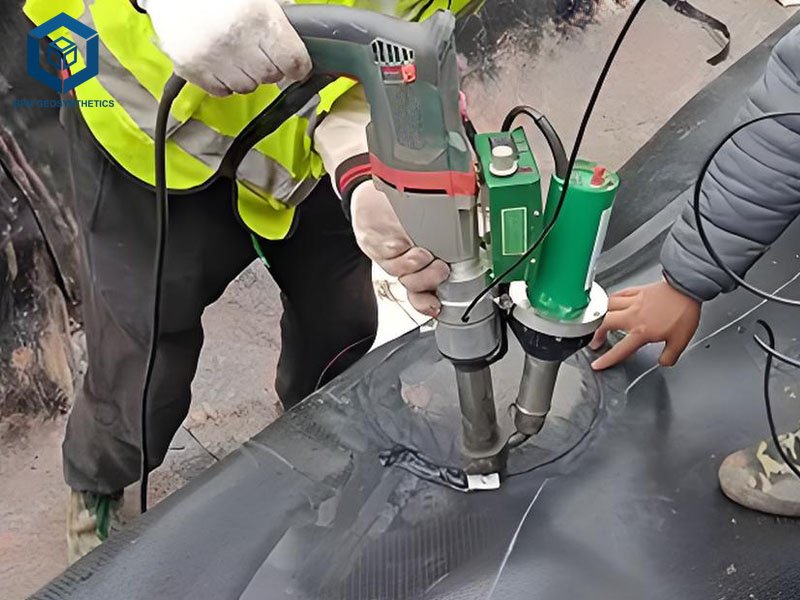
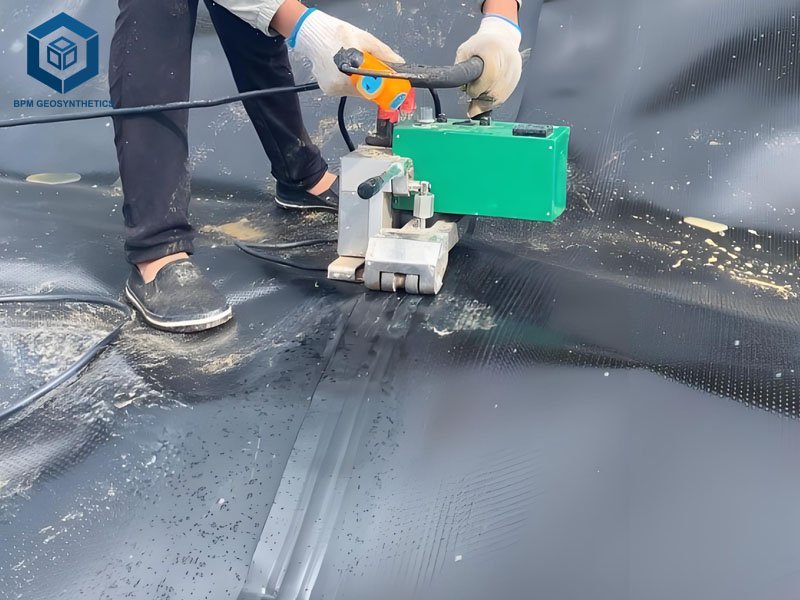
5. Maintenance and Longevity
Proper maintenance extends machine lifespan by 20–30%:
- Cleaning: Remove dust and debris weekly using a soft brush ($10–$20). Avoid harsh chemicals.
- Calibration: Check temperature and speed settings monthly to maintain ±2°C accuracy.
- Spare Parts: Keep rollers, nozzles, and wedges on hand ($50–$200 each) to minimize downtime.
- Storage: Store in dry, dust-free environments to prevent corrosion, extending life by 5–10 years.
Hot wedge welders last 10–15 years with 500-hour maintenance intervals, while hot air welders last 5–10 years with 300-hour intervals.
6. Cost Analysis
- Hot Wedge Welders: $2,000–$10,000, with $300–$500/year maintenance. ROI in 2–3 years for projects over 1000 m².
- Hot Air Welders: $500–$2,500, with $100–$200/year maintenance. ROI in 1–2 years for small projects.
- Rental Options: $50–$200/day for hot wedge welders, $20–$50/day for hot air welders, ideal for one-off projects.
- Tip: Bulk purchase discounts (10–20%) apply for orders over 5 units from suppliers like Alibaba.
7. Final Thoughts
Choosing the best dam liner welding machine is a critical decision that impacts the success of your geomembrane installation. Hot wedge welders, like the Leister TWINNY T7, excel for large-scale projects (500+ m²) with 0.5–8 m/min speeds and 90% seam strength, while hot air welders, like Grekkon’s models, are cost-effective for small projects and repairs. Key considerations include project scale, liner thickness (0.3–3 mm), site conditions, and operator skill. By prioritizing features like adjustable speed, precise temperature control, and ASTM-compliant seam testing, you can achieve leak-proof welds that last 50–100 years. For optimal results, invest in quality brands, proper training, and regular maintenance to reduce downtime by 25% and repair costs by 30%. Contact suppliers like BPM Geomembrane (+86-17862667669) for quotes and training to ensure your project’s success.

